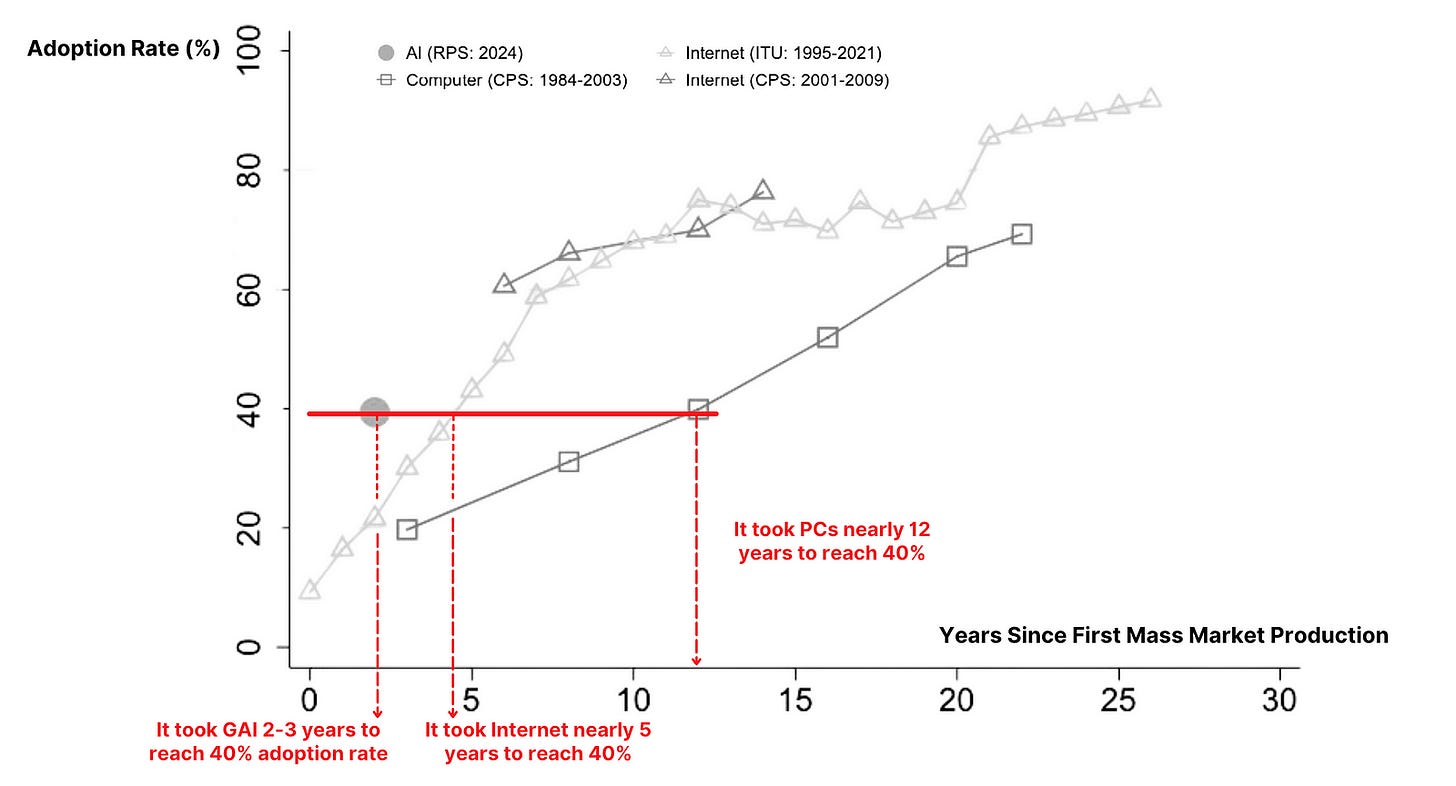Those of you who read my articles know I tend to compare technology’s history and lessons with today’s technological impact and growth.
As I mentioned, the Industrial Revolution, the rise of the Internet, and the current AI revolution share similarities. It’s not technology that is predictable; rather, human behavior is what we can anticipate. At the same time, technology accelerates our behavior and deepens the divides in our world.
I started with this paper, “The Rapid Adoption of Generative AI”, and other studies in the field.
As intriguing as they are, not everyone has the time to sift through academic papers. So, I’ve read the studies for you. I’m here to break them down into bitesize pieces so you can read or listen to my summary during your lunchtime or commute.
The data presented is fascinating and has inspired me to go down the rabbit hole. I ended up comparing the data presented in the paper with other economic factors.
Some Food for Thought
Is the rapid adoption of technology favoring particular groups over others?
Could AI widen the gap between the rich and the poor?
Do females have a higher AI adoption rate? The hidden reason behind whether each gender adopts AI or not.
Do young people or the middle-aged population prefer using AI?
Does AI truly correlate with productivity, as suggested by Sam Altman and other major tech CEOs?
Which questions are most relevant to you?
Here we go.
PC, Internet, and AI — Adoption History, the Similarities and Differences.
Here is a bit more historical context: Back in the day before PCs, office workers had typewriters, adding machines, and managing filing cabinets that took up half the room.

Then, the PC showed up in the 1980s. Suddenly, secretaries didn’t need a typewriter anymore; they had WordPerfect. Accountants switched from their calculators to Lotus 1–2–3 or early versions of Excel, allowing people to do what used to take hours or even days in minutes.
In the 1990s, when the Internet took over, office life changed again. It went from writing memos and mailing them across town to sending emails in seconds. People started using early collaborative tools like Lotus Notes and then moved on to web-based tools. Sales reps could access market data in real-time, customer service teams could manage support tickets faster, and it wasn’t just about efficiency anymore — it was about collaborating and being connected.
The accelerating technology adoption rate.
No academics make it easy when they put a figure on paper, of course. Because why don’t you work out the meaning on your own?
Enough with my sarcasm; let’s use AI’s current adoption rate of 40%, and compare how long other innovations took to reach that level.
Generative AI took 2–3 years to reach a 40% adoption rate in the U.S. That’s incredibly fast. How fast? If we put that in context.
The Internet took nearly five years to hit that same 40% mark.
PC took even longer — almost 12 years before 40% of people had one at home.
Speaking of standing on the shoulders of giants.
Unlike buying a big, bulky PC in the 80s or waiting for a cable company to get the connection to your neighborhood, AI tools are already on devices we all use daily.
Education shows how likely you are to be an early adopter.
As we compare AI adoption per education bracket to computer use in 1984, this seems like a real sense of déjà vu. It’s clear that people with higher education tend to be exposed to new tech tools first.

On top of that, the latest technology will also alter the workplace structure. This is highlighted in The Skill Content of Recent Technological Change, which discusses how computers have pushed jobs toward needing more educated workers.
Listen to this episode with a 7-day free trial
Subscribe to 2nd Order Thinkers to listen to this post and get 7 days of free access to the full post archives.












